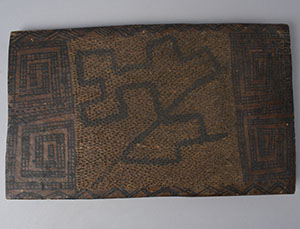-News-

The Manoic scraper/grater comes from a Waiwai commuity in Northern Brazil, it was collected in the 1950s. Manioc, also known as cassava (Manihot esculenta), is a subsistence crop for peoples throughout the Amazon, South America, and regions in Africa and Asia. There are 5,000 known varieties of cassava, many of which are poisonous in a raw state and require elaborate cooking processes to remove traces of toxic cyanide.
This grater (46 x 29 cm) is made in typical Waiwai fashion, constructed from the hard wood of a rainforest tree with hundreds of tiny slivers of sharpened stone hammered into the board and arranged in diagonal lines. The surface is coated with red annatto (bixa orellana) mixed with resin and latex from the cow tree (couma macrocarpa) which acts like a glue to keep the stone chips in place. Designs are then painted in black (made from masticated charcoal and juice from the genipap tree (genipa americana). Usually the design has geometric borders and a central figure, often an animal—a lizard is depicted here. The backside of this grater is also decorated with geometric cross designs. These Waiwai graters are very valuable and widely traded in exchange for manufactured goods from other indigenous communities. The scraper will be part of the upcoming Maxwell exhibition Heartbreak: A Love Letter to the Lost National Museum of Brazil.
92.28.16 Waiwai Manioc scraper, Roraima Region, ca. 1950s
Some links to photos and videos of manioc food preparation:
https://www.youtube.com/watch?v=aehoo13UIV4
https://tinyurl.com/y23abrc4
Post by Moira Garcia

